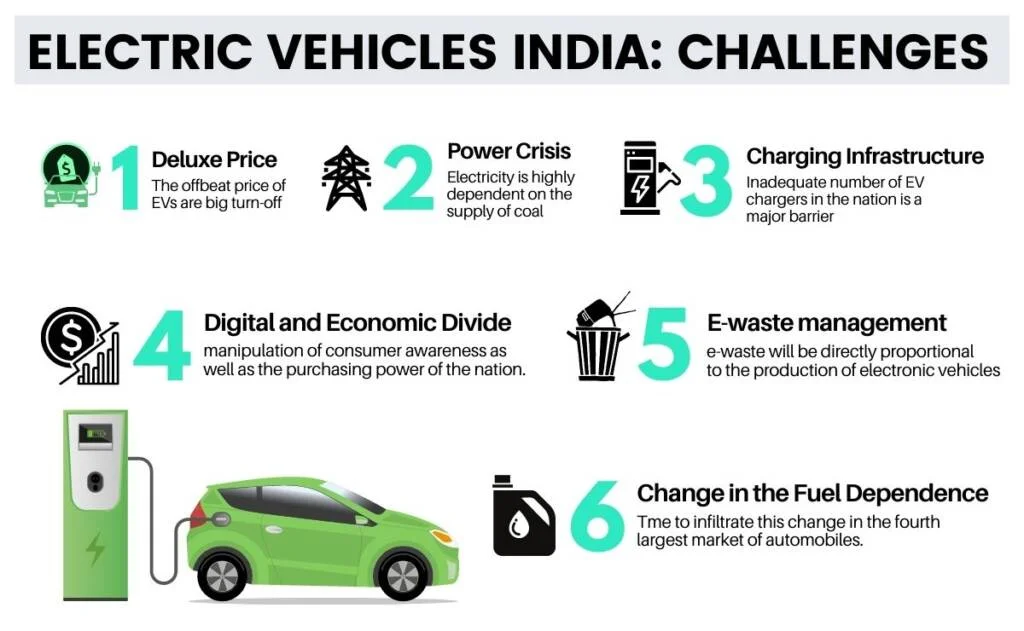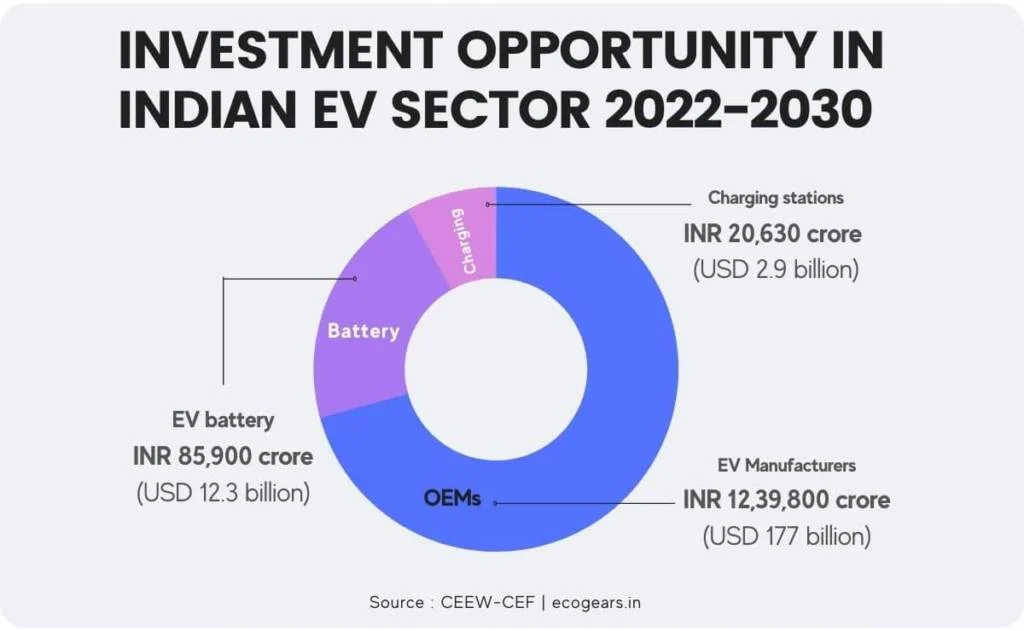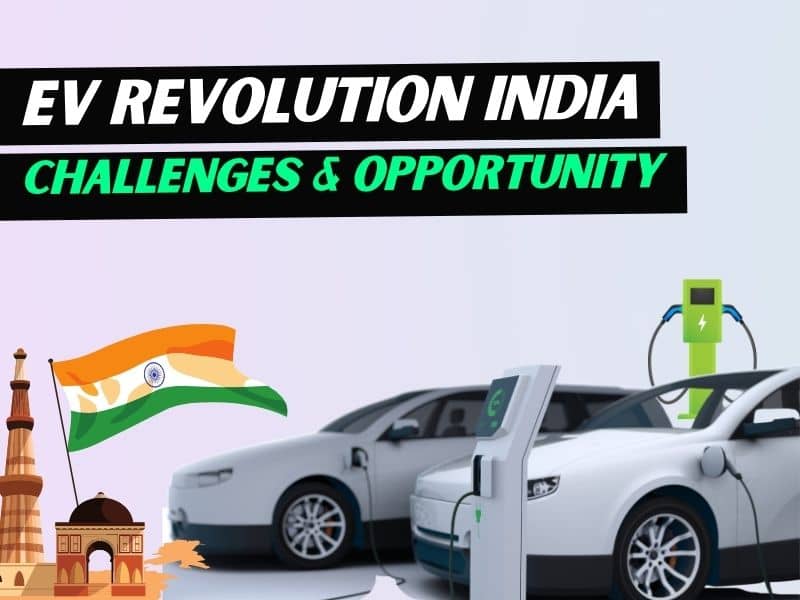For faster and better adoption of EVs in India, it is crucial to address the economic and digital disparity as well. Despite the challenges, the electric Vehicle Revolution has created a billion-dollar investment opportunity in India. Here is a report of the Indian EV revolution and electric vehicle challenges and opportunities in India.
Highlights
- The swollen consciousness after the pandemic has favored the EV market abundantly.
- The shortage of coal supply in India throttle is the dependence of electricity in the nation affecting the EV demand.
- For better EV future, the e-waste need to be addressed urgently.
Why is the Indian automobile market making a full tilt towards EVs? Considering the digital and economic divide, how will EVs infiltrate India so swiftly? India is largely dependent on fuel, mostly for automobiles. What are the electric vehicle challenges and opportunities in India?
With the hike in the prices of fuel and the swelling consciousness after the pandemic, the modification in the demand for fuel-run vehicles to electric vehicles is evident.
An eloquent step by the government supporting this shift was seen in the budget of 2019, wherein, the GST rate tumbled from 12 % to just 5%. This is how the government nudges the end-user to prefer EVs.
There has been a rise in the sales of electric two-wheelers by 64% and 68% on four-wheelers. Even though this rise is calculated on a small base, it seems to be optimistic.
Nagesh Basavanharli, the group CEO and MD greaves cotton, in one of his podcasts said, “Covid did us a favor as sustainability and people’s preference for greener vehicles increased, as did the slant towards private mobility.
We believe the industry is just getting started with the electric vehicle revolution in India and there are exciting times ahead of us”. India is firmly heading towards the adoption of EVs, however, on the flip side; the nation is confronted by several electric vehicle challenges and opportunities too.”
Current EV scenario
The government of India decided to extend the FAME II policy with an outlay of INR 10,000 crore by 2 years till 31 March 2024. The scheme was launched to incentivize EV buyers, manufacturers, and station providers with an aim to make electric vehicles more affordable for the public.

India being the world’s largest untapped electric vehicles market recently allowed for 100% direct foreign investment under automatic route.
To accelerate the adoption of electric vehicles and lower nation-wide carbon foot-print, the Union Budget 2022-2023 announced an EV battery-swapping policy for nationwide adoption specifically for housing societies.
READ MORE: State-wise electric vehicle subsidies in India | Top electric cars in India by sales
Finance minister Nirmala Sitharaman introduced “Battery as a Service(BAAS) as a business model to accelerate the development of fast-charging networks in metros and connecting highways with a vision to tackle the electric vehicle challenges and opportunities in India.
Challenges for the Indian EV sector
Here are some of the challenges faced by the Indian EV sector in detail:

EV – Deluxe Price
Indians are known to passably evaluate their every purchase. This is the reason Indian consumers prefer diesel cars despite cost differences and pollution rates. Because of the abounding subsidies provided by the government to all the stakeholders, that is, the manufacturers, traders, and the vendees, it could have been extraordinarily affordable.
However, in stark contrast, the prices of EVs turned out to be offbeat, solely because of the cost of high-capacity batteries, mainly because of the lithium-ion cell technology, which at present is not manufactured by our domain.
To make EVs economical, India might have to usher in the manufacturing of high-capacity batteries for which India runs low on resources and lacks accessibility.
Power Crisis
As approximately 70% of the electricity produced by this nation is derived from power plants, India is highly dependent on the supply of coal. As of October 2021, the shortage in the coal supply throttles the dependence on electricity in India. Henceforward it becomes pivotal for the government to set up clean and sustainable electricity yielding units.
Accessibility of EV and Recharging Facility
Whilst most of our population still resides in rural areas, EVs become inapproachable albeit that India has over 65 pure EV showrooms, spreads over 52 different cities.
Even though 27 charging stations and 30 battery swapping stations have already been installed it fails to carry the current demand. Nonetheless, according to FAME II (Faster Adoption and Manufacturing of Hybrid and Electric vehicles- by two years) the government plants on adding around 2877 mo public EV charging stations by 2024 with coverage Pan India.
Digital and Economic Divide
According to the world inequality report 2022, “India stands out as a poor and an equal country with affluent elite. While the top 10% hold 57% of total national income”. The Digital and Economic divide of the nation plays a major role in the manipulation of consumer awareness as well as the purchasing power of the nation.
The declining income of most of our population and also the expansion of the inflationary gap would eventually decrease the demand for EVs as EVs are not yet inexpensive.
Change in the existing Fuel Dependence
As of September 2021 the demand for fuel springs up 11% in the month of August, making the total consumption around 16 mn tonnes. It may take a considerable amount of time to infiltrate this change in the fourth largest market of automobiles. Consumer awareness and monetary distribution again play a major role in the electric vehicle challenges and opportunities in India.
Apart from these problems, India also needs to find out a solution for E-wastes, as e-waste will be directly proportional to the production of electronic vehicles. E-waste management has already been an issue for years in India. If a sustainable solution to this problem is not found, it could be diverting from the whole eco-friendly point of view.
If viewed from a broader perspective and time given to this plan, the scads of these challenges will be solved. As the consumption of fuel decreases, the government will be able to save a lot on crude oil imports. This money could be further invested in the generation of cleaner power.
Alongside the subsidies provided to the manufacturing unit, the increase in production by a large scale would also decrease the prices by a little but could be effective. Under FAME I and II the government also plans on setting up houses of EV showrooms all across India which would also help in spreading consumer awareness.
Investment Opportunities in the Indian EV sector
The flux of electric vehicles in India has created investment opportunities in different sector sectors catering to EVs.

The biggest market is for the EV manufacturing segment, wherein, over a period of 8 years FY2022-FY2030, the transition to electric mobility and to reach the projected EV sales, the overall production cost and investment required would be INR 12,39,800 crore (USD 177 billion).
The growth of the electric vehicles market will lead to rising of the EV battery manufacturing sector too. To meet this growing demand, battery manufacturers will need to substantially level up their production capacity, which will require huge electric vehicle investment opportunities of about USD 17 billion, if manufactured indigenously.
To meet the goal for 30% EV penetration by 2030, the demand for EV charging infrastructure would create an investment opportunity of USD 3.2 billion in the electric vehicle charging stations market.
Conclusively, with better initiative and everything falling into place, India could adopt greener means of transport making negligible pollution. Hence, it’s never too late to mend to meet the electric vehicle challenges and opportunities in India.

Very helpful article. Excellent points covered. Need one help though, which Investment opportunities will be the most profitable among them? Wanting to invest in the Indian EV sector.
Glad you reached out Mr. Rohan
As of now, EV charging station business is on the boom, so one can go for it